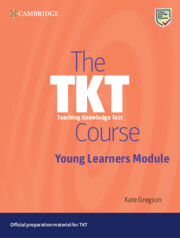Book contents
- Frontmatter
- Acknowledgements
- Contents
- Introduction
- Part 1 Knowledge of young learners and principles of teaching English to young learners
- Part 2 Planning and preparing young learner lessons
- Part 3 Teaching young learners
- Part 4 Assessing young learner learning in the classroom
- Follow-up activities: Answer keys and commentaries
- List of terms found in the TKT Glossary
- Glossary of TKT: Young Learners terms
- Test tips for TKT: Young Learners
- Teaching knowledge test young learners: Practice test
- Sample test answer sheet for TKT: YL practice test
- Answer key for TKT: YL practice test
Unit 1 - Children as language learners: What are the characteristics of children as language learners?
Published online by Cambridge University Press: 14 March 2024
- Frontmatter
- Acknowledgements
- Contents
- Introduction
- Part 1 Knowledge of young learners and principles of teaching English to young learners
- Part 2 Planning and preparing young learner lessons
- Part 3 Teaching young learners
- Part 4 Assessing young learner learning in the classroom
- Follow-up activities: Answer keys and commentaries
- List of terms found in the TKT Glossary
- Glossary of TKT: Young Learners terms
- Test tips for TKT: Young Learners
- Teaching knowledge test young learners: Practice test
- Sample test answer sheet for TKT: YL practice test
- Answer key for TKT: YL practice test
Summary
LEARNING OUTCOMES
By the end of this unit, you will…
KNOWLEDGE: know about some characteristics children bring to language learning SKILLS: be able to make connections between activity types and the benefits they bring to the young learner classroom
■ Starter Question
Before you begin this unit, read the starter question and make some notes. Then read the commentary and compare it to your notes.
Why do we teach English to 6–12-year-old children? Note at least three points.
COMMENTARY
Nowadays, children around the world are beginning to learn English from an ever younger age at school and outside of school (extracurricular). This is partly because of a popular belief that starting earlier with English will give children greater linguistic benefit than starting later, so it will allow them to finish school with a higher level of English, ready for their futures as young adults. However, research shows that older learners usually make faster progress and learn more efficiently as they are cognitively more mature, have better learning skills and are more skilled at interaction and communication (see Read, 2003 for a more detailed discussion on this).
Despite this, there are plenty of benefits in other areas to an earlier start. 6–12-yearold children are still developing cognitively, physically, socially and emotionally, as learners, as individuals, and as thinkers; learning English can play a part in this development. Classroom learning at primary level, usually from around 5 or 6 until 10 to 12 years old, is often based around fun and engaging activities which help children develop in different areas, and English language learning also lends itself to these kinds of activities more than to formal desk-based learning. If positive learning conditions are established through such activities, then it is likely that learning English as a foreign language may help children develop positive attitudes and improved motivation for English in preparation for secondary school. Learning English can also help them to develop personal and educational skills as well as the ‘4 Cs’: Communication, Collaboration, Critical thinking and Creativity, which are important to their all-round development and being ready for the 21st-century world.
- Type
- Chapter
- Information
- The TKT Course Young Learners Module , pp. 8 - 15Publisher: Cambridge University PressPrint publication year: 2024

